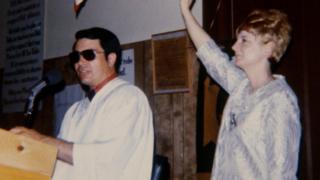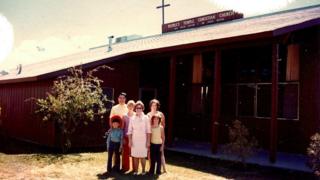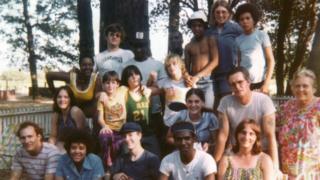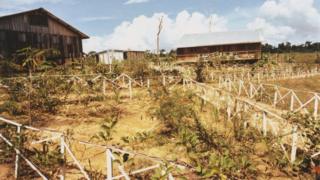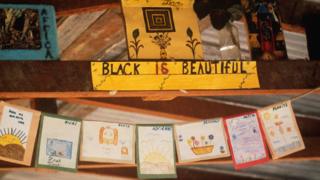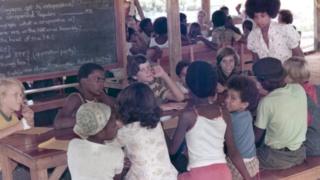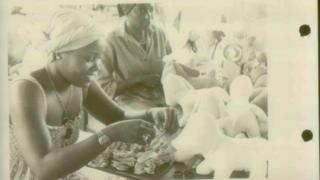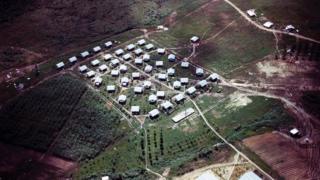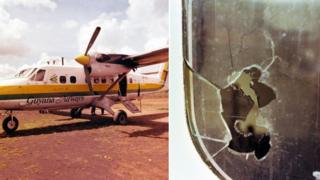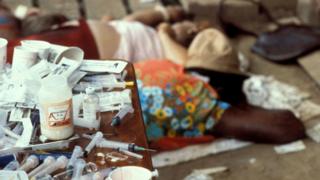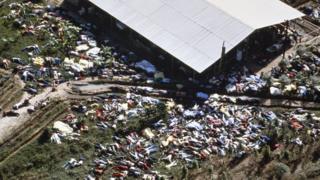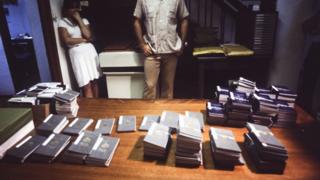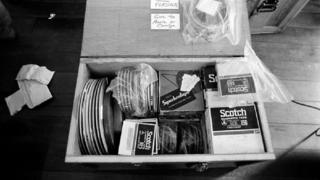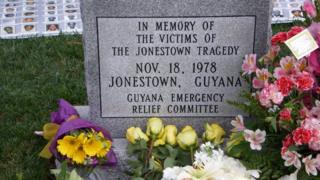‘I survived the Jonestown cult massacre’
Sunday 18 November is the 40th anniversary of the notorious Jonestown massacre where more than 900 people died at a settlement run by Christian cult leader Jim Jones.
Ahead of the anniversary, one survivor – Laura Johnston Kohl – spoke to the BBC about how she narrowly escaped death, and how she and others have rebuilt their lives in the decades since.
Warning: This article contains graphic images of death
Growing up in Washington DC in the 1950s and 1960s, Laura Johnson was no stranger to activism.
By 1970, when she joined the Peoples Temple in California aged 22, she had already been tear-gassed protesting against the Vietnam war, worked with the Black Panthers and attended the famous 1969 Woodstock festival.
“My life was in turmoil, I had a failed marriage and I was looking for a place to be political in a safer environment after a series of bad decisions,” she recalls.
She attended a few meetings at the group’s headquarters in Redwood Valley in northern California and was soon won over by their ideals of benevolence and racial equality.
Jim Jones, a charismatic Christian preacher, had set up the People’s Temple as a racially-integrated church group in Indianapolis in 1956 before relocating to California a decade later.
Jones spoke of an impending nuclear apocalypse, and believed his separatist “apostolic socialist” community could thrive in the aftermath.
The group, although religious, was founded on socialist ideals – providing healthcare and other social services for its diverse members.
“It was the community I was looking for – I was looking for equality and justice, and there were people of all backgrounds and races,” Laura says.
“In 1974, the cult leader Jim Jones said he wanted us to find a place away from all the drugs and alcohol in America,” she recalls.
“We found Guyana, in South America, which was the perfect country for us to move to. It was a beautiful country with remote areas that we could populate.”
In 1977, Laura and hundreds of others uprooted their lives to re-settle to the Peoples Temple Agricultural Project – informally known as Jonestown after its leaders’ name.
“I had no concerns about moving there. I was adventurous and I was delighted about the opportunity to live in the rainforest,” she says.
The “socialist paradise” abroad would allow Jones and his group to practice their way of life away from the intense media scrutiny that was beginning to amass back in California.
But it wasn’t the complete paradise they were promised.
The settlement, in the north of the Guyana, was extraordinarily remote but became plagued by agricultural deficiencies that prevented the group from being self-sufficient.
Members lived together in small communal houses, and reported working long days in sweltering heat during their increasingly politicised daily lives.
Laura lived at the main Jonestown site until October 1978.
“My work there was meaningful and fulfilling,” she recalls, “The people of Peoples Temple were who I wanted to live my whole life with.
“They were wonderful people. Other survivors might say differently, but for me, I was delighted. It was not an unhappy part of my life.”
At the end of October Laura was asked by Jones to move to Georgetown – the Guyanese capital a 24-hour boat ride away – to work at the church headquarters.
She believes her relocation was a calculated move by Jones, brought on because of growing scrutiny and an impending visit by California Congressman Leo Ryan.
“Jim Jones looked at zealots [like Laura – people who would speak positively about People’s Temple] and stacked the deck in Georgetown for Congressman Ryan’s visit,” she says.
The politician was heading up an investigatory expedition to the compound after family members in the US expressed concern their loved ones were being held against their will.
In one high-profile case, the defector parents of a child called John Victor Stoen – who Jones claimed he had fathered – publicly battled for custody.
And meanwhile, Laura recalls, “Jim Jones’s state of mind was deteriorating and the Jonestown experiment was beginning to fail.”
“People were accusing Jim Jones of abducting their children, and his secretaries had run away with scandalous information about what was going on.”
In May 1978 an aide close to Jones, Deborah Layton Blakey, escaped to Georgetown to seek refuge at the American Embassy.
She submitted an affidavit which spoke about the “tyrannical hold” of the Messianic Jones who she said would broadcast ranting sermons on loudspeakers for hours at a time – consumed by conspiracy theories about the US government, defectors and concerned relatives.
She also reported that compound residents suffered food shortages and were at times plagued by illnesses like diarrhoea.
“Jonestown wasn’t set up for so many people – we were 1,000 – and we were not self-sufficient. So Jim Jones was feeling the pressure,” Laura recalls.
“His drug addiction and his personality disorders were getting worse. He was less and less able to function.”
Survivors recalled “white night” events, sometimes weekly, where Jones would declare a crisis about the compound’s safety.
Sometimes these involved mock mass-suicides where followers, including children, lined up and drank liquid they were told was laced with poison, only to be told it was a test of loyalty.
When Congressman Ryan visited with a delegation in November, he brought along concerned relatives of Temple members and journalists to document the trip.
After initial resistance, the group were permitted access and given tours which presented a largely pleasant depiction of everyday life.
Charles Krause, a Washington Post reporter on the trip, would recall: “Contrary to what the ‘Concerned Relatives’ had told us, nobody seemed to be starving… everyone seemed quite healthy.”
The group stayed outside of the compound overnight and returned the next day. During their time there the group were approached by at least a dozen followers asking to return to the US with them.
As the delegation waited for their returning flight, a cohort of Temple gunmen ambushed the group and opened fire, killing five people including Congressman Ryan.
Back at the compound, Jones simultaneously urged his more than 900 followers to take their own lives, warning that the Guyanese military would invade and take their children because of the airstrip shooting.
Vats of fruit punch laced with cyanide were mixed and distributed around, as in the rehearsals.
“Jim Jones was a con artist – he made everyone feel he was their father,” Laura says of the leader.
“He would say to them: ‘you can’t go back, you have no money’ which was true, they had put it all in the church.”
“They feared repercussions of the death of the Congressman,” she says. “He lied to them every day, he fed them paranoia. They had no recourse.”
‘Everybody is dead’
Back at the Guyana headquarters 150 miles (240km) away, members were alerted to the order.
“Jim Jones’s secretary, Sharon Amos, received a message on the radio sent to Georgetown, San Francisco and Redwood Valley,” Laura recalls.
“It said: ‘Everybody in Jonestown is dying or dead. Everybody else needs to commit revolutionary suicide right now. We are all doing right now.'”
Laura says two of Jones’ children, who were visiting the capital as part of the Temple’s basketball team, refused to follow instructions and told other branches to disregard them.
She had been out of the building when the message received, and returned to find Guyanese national defence forces bringing out the body-bags for the secretary and her children.
“It’s hard to know what would have happened if I and the others in Georgetown had received those instructions,” she says. “We had options there – you could walk down the street and see people, get in a car, or get in an embassy.”
“I think if I were in Jonestown and I saw 900 people who I loved make a choice, I can’t imagine wanting to survive that.”
Laura says back at the headquarters they began to hear reports about the death-toll at Jonestown: first saying 300, then 600 dead.
“We were just all devastated. We were crying, like I still cry now. I was a mess. Many of us were inconsolable,” she says.
“Some people went out to try to identify some of the people.”
“Their bodies were left out in the open, in the middle of the rainforest, in a foreign country. Every possible thing that could be botched, was botched. There is no real way to know exactly who died how. It was just horrific.”
The total death toll, including the airstrip killings and Jones himself, totalled 918 people.
Krause, who survived the ambush and was the first journalist allowed on the scene of the massacre, said that even dogs and the Jonestown pet chimpanzee died alongside the residents.
“I realized that Jones had meant to leave nothing, not even the animals, to bear witness to the final horror. There were to be no survivors,” he wrote in the Washington Post shortly after.
Before the events of 11 September 2001, Jonestown was the largest single incident of intentional civilian death in American history.
Laura returned to the US at the end of November 1978 and moved back into the People’s Temple community in California – a decision that she says she had no qualms about.
“They were my family. I had lived with them for eight years, I knew them so intimately,” she says. “I never had any fears. Jim Jones was the only one who was invested in the deaths.”
“We had gone through this collective trauma together. And it made sense to go through the healing together.
“My mother and sister could not understand how I had gotten into the Temple, how I stayed over there… they couldn’t get it. They couldn’t grasp the loss.”
After a year back at the People’s Temple, Laura joined another community where she met her husband and lived for a decade where they had a son together.
“Then I said ‘I’m done, I want to be an adult now’. I went back to school, and I started teaching in 1995,” Laura says.
‘No closure’
Having avoided talking about the traumatic experience for almost two decades, Laura eventually met up with Temple survivors for the first time in 1998.
“There had been no forum to have negative discussions until then,” she says. “Twenty years later, we could finally sit down in a circle and have a conversation about what happened.”
The trauma of working out the minority who had lived became traumatising and overwhelming, so on meet-ups she found herself surprised to encounter people she did not know had made it out.
The anniversary – 18 November – has become a day for her and others to honour the more than 900 lives that were lost.
“Meeting these other people for these anniversaries has helped me rebuild my life – the reality is that I am not just Laura Kohl, I am the Laura Kohl who went to People’s Temple, who survived People’s Temple and who continues to kick ass,” she says.
“It’s so much a part of me. I am who I am because I survived People’s Temple. It drives me every day.”
“There’s no closure for Jonestown – it’s not fixable,” she says.
“I could hate Jim Jones but then so what? He already died. There’s no point in living with hatred.
“Instead, I educate people about cults. I talk a lot about making your own decisions.”
‘One big dysfunctional family’
Decades on, this Sunday’s memorial will bring some survivors and their relatives together for the first time.
“We are one big dysfunctional family. It doesn’t matter if you were somebody who had a lawsuit against Jim Jones or somebody there the last day, we were survivors and we made it through,” she says.
“We are here 40 years later and that’s something to celebrate.”
“Sometimes when we gather, people speak or we sing songs. It’s a sacred time and space, we forget that there is another world,” Laura says.
“All of us survivors show we can do it without Jim Jones, and he is not missed.
“Now I have sadness that I lost good friends: I’m sad that some of the best people I ever knew in my life, people who committed so much that they then lost their lives.
“I saw an absolutely fantastic community of all races, all backgrounds, all socio-economic levels and we did a masterful job creating this community for 1000 people,” she says. “That kind of community can exist, it did not depend on Jim Jones, it depended on really committed people.
“That gives me a lot of hope, it instils confidence that wonderful people can do wonderful things. I am still an activist now. I know we can make a difference, I saw it, and I don’t give up.”
All photographs copyright.
Source: Read Full Article


